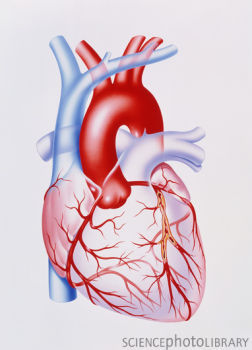 根据一篇发表在《科克伦图书馆》(The Cochrane Library)上的系统评论,干细胞疗法可适度改善心脏病发作后的心脏功能。但是,发表这篇评论的研究人员称,需要进行更大规模的临床试验来确定这一疗效是否意味着延长寿命。
根据一篇发表在《科克伦图书馆》(The Cochrane Library)上的系统评论,干细胞疗法可适度改善心脏病发作后的心脏功能。但是,发表这篇评论的研究人员称,需要进行更大规模的临床试验来确定这一疗效是否意味着延长寿命。
在心脏病发作过程中,心脏某些部位的血液供给被阻塞的动脉切断,从而给心脏组织造成损害。受损部位的细胞开始死亡。这种现象被称为细胞坏死,在接下来的数天乃至数周,坏死部分可能会生长,最后使得心脏的一大部分不能收缩,增加了发生进一步的心脏问题的风险。干细胞疗法利用来自患者自己的骨髓的细胞来试图修复并降低这一损害。当前,这种治疗只能够在与科学研究相关联的医疗机构进行。
这篇评论的作者收集了所有现有证据来询问成年骨髓干细胞是否能够有效地预防并修复由心脏病发作引起的损害。2008年,一篇基于13项干细胞疗法临床试验的Cochrane评论提出了相同的问题,但是新的评论增加了20项最近的试验,从所有33项试验中得出结论。通过更长的跟踪研究,最近的试验更好地反映了治疗后数年内该疗法的疗效。
参与试验的患者总数为1765人。所有患者都已进行了血管成形术,这种传统的治疗方法使用一个气球将阻塞的动脉打开,重新引入血液供给。评论的研究结果表明,利用骨髓干细胞(BMSC)的干细胞疗法可以对心脏功能产生适度的长期改善功效,最长可持续五年。但是,没有足够的数据来得出提高存活率的确切结论。
“相比于标准治疗方法,这种新的治疗方法可能会带来心脏功能的适度改善”,本研究的第一作者,英国牛津“约翰瑞德克里夫医院(John Radcliffe Hospital)”的“英国国民医疗保健服务系统(NHS)”血压与移植部干细胞研究实验室的Enca Martin-Rendon说。“干细胞疗法还可以减少后期死亡或者遭受心力衰竭的患者数量,但是基于迄今为止接受治疗的患者数量较少,目前尚缺乏显著的统计证据。”
根据这篇评论,目前制定标准医学实践指南还为时过早。作者称需要进一步的研究以确定标准方法,其中包括细胞剂量、细胞移植的时机以及测定心脏功能的方法。“由于使用大量不同的方法,这些研究难以进行比较”,Martin-Rendon说。采用标准化治疗步骤的更大规模试验将有助于我们了解这一治疗方法是否真正有效。
最近,欧洲心脏病学会(European Society of Cardiology)干细胞与心脏修复特别工作组获得了欧盟研究与创新第七框架计划(EU FP7-BAMI)的资金支持来开始这项试验。BAMI试验的首席研究员、这篇Cochrane评论的联合作者Anthony Mathur说:“BAMI试验将会是对已经历心脏病发作的患者进行的最大规模的干细胞疗法试验,将检验这一疗法是否能够延长这些患者的生命。”

 Stem cell treatment for acute myocardial infarction
Stem cell treatment for acute myocardial infarction
Enca Martin-Rendon, Susan Brunskill, Carolyn Doree, Chris Hyde, Anthony Mathur, Simon Stanworth, Suzanne Watt
Background: Stem cell therapy offers a promising approach to the regeneration of damaged vascular and cardiac tissue after myocardial infarction (MI). This has resulted in multiple randomised controlled trials (RCTs) worldwide.
Objectives: To critically evaluate evidence from RCTs on the effectiveness of adult bone marrow-derived stem cells (BMSC) to treat acute MI.
Search methods: MEDLINE (1950 to August 2007), EMBASE (1974 to August 2007), The Cochrane Library (Issue 3 2007), and CINAHL (1982 to August 2007) were searched. In addition LILACS, KOREAMED, INMED, Current Controlled Trials Register, the UK National Research Register and other handsearching was undertaken to August 2007.
Selection criteria: RCTs comparing autologous stem/progenitor cells with no autologous stem/progenitor cells in patients diagnosed with acute myocardial infarction (AMI) were eligible.
Data collection and analysis: Two reviewers independently screened all references, assessed trial quality and extracted data. Meta-analyses using a random-effects model were conducted and heterogeneity was explored using sub-group analyses.
Main results: Thirteen RCTs (811 participants) were included. There were insufficient events on clinical outcomes like mortality to draw clear conclusions. Stem/progenitor cell treatment does not appear to be associated with an increase in adverse events but again the data do not allow clear conclusions. Left ventricular ejection fraction (LVEF) was the outcome with most results and there was marked heterogeneity between trials. There was however a consistent pattern indicating that BMSC treatment generally improves short-term LVEF, with similar trends for left ventricular end systolic and end diastolic volumes (LVESV and LVEDV), infarct size or cardiac wall motion. There was a positive correlation between cell dose infused and the effect on LVEF measured by magentic resonance imaging.
文献链接:https://onlinelibrary.wiley.com/doi/10.1002/14651858.CD006536.pub2/abstract







